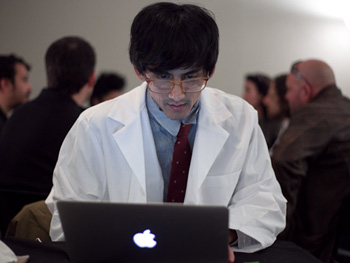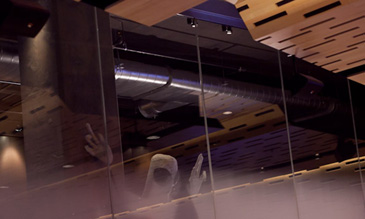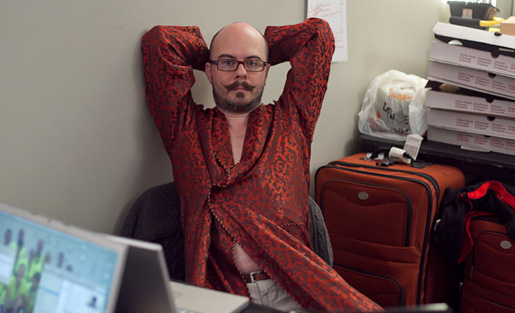It sounds like the start of a joke: A clown, an actress, a lighting designer, and a transmedia storyteller get locked in a room. Did I mention the clown is also a software developer? The result of this collaboration is the winning team of Story Hack: Beta, better known as Team Cupcakes and Rainbows. Seriously.
Story Hack: Beta was an event produced by StoryCode, a not-for-profit dedicated to the future of cross-media storytelling, in partnership with the Film Society of Lincoln Center. Seven teams of four entered the Elinor Bunin Munroe Film Center on Saturday morning and didn’t leave until after the presentations and a winner was announced Sunday evening. Team Cupcakes and Rainbows wasn’t the only group composed of an interesting mix. Team US Maple included a web developer, a dramatist, a producer and a screenwriter.
Brian Clark, CEO of GMD Studios, was one of the mentors provided to the teams for the event. He spoke to me about this type of collaborative process on Sunday, the second day of the hack. “In most hackathons, there is already an established process. But with this kind of thing, artists are trying to develop a new language of dialogue with each other. You’ve got programmers, graphic artists, and writers trying to figure out how you can create a vision you can all work towards when your work processes are so different,” he said. “That’s the angst you would have seen last night at 3:00 a.m., but I think that’s where the exciting time is right now with interactive today. We’ve got to get storytellers and programmers to be able to understand each other, because those two things are becoming inexorably intertwined.”
Making Sense of the Chaos
The idea of bringing people together from various fields was at the heart of Story Hack: Beta. StoryCode co-founder Aina Abiodun opened the demo part of the event with these words, “Ladies and gentlemen, 18 months ago, we were 20 people in a room looking for other people like us to make sense of this chaos. Chaos is the maddening pace at which technology and media appear to be shifting.” She went onto discuss the rapid changes in technology and the need for storytellers to engage the tech-savvy audiences of today. She concluded her speech with, “We must have the courage to look forward and boldly claim our place. Make no mistake, we storytellers are a pliable, crafty, adaptable breed. Today, we give you a glimpse into what is possible.”
Which brings us back to possibilities. What ideas are possible from collaborative, creative brainstorming from teams with names like Team Cupcakes and Rainbows, Team Vile Inc., and Team Awkward Hug? Animated astronauts, bed bug metaphors and futuristic dating were just a few of the creative demos presented at the conclusion of the hackathon.
The ‘Hack’ Culture

What is a “hackathon” anyway? A condensed Wikipedia definition would be an event in which tech folk get together and collaborate intensively for a period of time, somewhere between a day and a week. Hackathons can have a specific focus or be intended for educational or social purposes.
Michael Knowlton, one of the co-founders of StoryCode, explained to me that while the “hack” culture doesn’t exist in the entertainment space, they felt it was applicable for what they wanted to achieve. Like other hackathons, Story Hack: Beta had criteria and rules. The teams were given the challenge to design a cohesive narrative spanning three or more technological platforms and to execute a single one over the course of 48 hours. The platforms could include mobile, social, live performance, web-based, or gaming, either console or live.
The narrative part of the challenge asked the teams to focus on the theme “Courage,” as the only storytelling guideline. The teams were required to integrate at least one of the technology sponsors, Kaltura, Logicworks, Social Samba and Twilio, into an executed hack. (The teams were giving extra credit if they incorporated more than one.) Finally, all the teams had to creatively use a dress from the brand sponsor, Free People, in their hack. The dress had to appear in the platform executed. All this information was provided to the teams at an orientation session a week before the event, and Free People provided all the teams with the dress.

Steve Coulson, creative director of Campfire, was also a mentor for the weekend’s event and shared his experience watching this diverse group of people collaborate. “It was fascinating, because storytelling can often be a solo exercise, conducted outside the pressure of short deadlines and direct competition,” he said. “Throwing people together in competitive teams, with a restrictive, brief and tight timeline made this feel as much like a boot camp as a story workshop, with all the camaraderie and stress of that type of environment.”
So what was the magic that Team Cupcakes and Rainbows found while collaborating? They were obviously an audience favorite, and when I spoke with the judges afterwards, they all agreed Team Cupcakes and Rainbows were the clear winners.
Abiodun shared with me that StoryCode had turned away about two-thirds of the applicants for the event and only two-thirds of the teams actually applied as teams. I wondered if Team Cupcakes and Rainbows had entered the event already well-versed in collaborating together and that was part of their synchronicity. I interviewed the team members, Gyda Arber, Brian Fountain, Allen Hahn and David Gochfeld, about their process leading up to and during the event, as well as their mishap during the demo of their project, FutureMate. The following is an edited transcript of that discussion.
Q&A
Collab Central: How did the members of Team Cupcake and Rainbows become involved in Story Hack: Beta?
Brian Fountain: Gyda Arber, Allen Hahn and I were existing members of the StoryCode meet-up group. When the announcement was made, we all signed up. Initially, Gyda and I reached out to an independent filmmaker and technologist named Mark Harris to form a team, but Mark had to drop out because of scheduling. Around the same time, Allen contacted Gyda about collaborating, so he came on board next, and Gyda recommended David Gochfeld as the fourth.
I know participants were given the criteria and rules at an orientation meeting about a week before the event. What kind of preparation did you do in the week leading up the event?
Fountain: One of our collaborators, Allen, splits his time between Pittsburgh and New York, so we decided to hold most of our meetings over Google Hangout. We had four or five evening sessions of 90 minutes to three hours. We also had a five-hour video shoot the day before the hack.
How did your team come up with the idea for your project, FutureDate?
Fountain: It took us around six hours of discussion to find the core idea. We talked about courage and the various ways it can be demonstrated. David had this idea about “small moments of courage,” like telling someone you love them. We all felt that was a terrific place to start and began to spider web out from there. We discussed some really extreme scenarios like abductions and hauntings, but nothing seemed to click. As I joke, I tossed out the phrase, “post-apocalyptic dating” and Gyda’s eyes, lit up. “Oh my God — that’s it.” She rattled off a few ideas of what it could be to the group, and within minutes, we were all onboard.
Allen Hahn: In conceiving the story, we had also explored a more serious angle, but soon recognized the potential downside of being overly earnest and losing the audience. From there, it became clear that the best approach would be to execute the presentation as a dark comedy.
What was the vibe of the team during the actual event? Did you have any ideas that you had to drop at the last minute?
Fountain: The flexibility required in a situation like this is quite staggering. At one point, Gyda had created content that conflicted with some story elements Allen had created. Which normally is not a big deal, but Allen’s content was scheduled to be sent out via Twitter 15 minutes from when the problem came to light. We talked it over, and Allen said, “I don’t know if I can make that work. Give me a minute.” At which point, he left the room, did a couple laps around the lobby, and came back about three minutes later. “I know how to fix it,” he said. He sat down and tweaked the characters, situation and dialogue in about 10 minutes. This all happened at 4 in the morning.
Hahn: The vibe was always supportive, and even when there was disagreement about story points or design, invariably they led to a tighter final edit and a stronger story because of it.

Who handled what in the hack?
Fountain: When I was not working on the front end of the speed date demo, I was uploading assets, reviewing copy, or punching up the script. Allen did the story outline and content for the anti-government side of the story. This became the “manifesto” as well as the Twitter feed and on-site propaganda campaign for the audience at Lincoln Center Film Society to encounter around the demo.
David’s baby was the massive tech showpiece that was our finale. He sat down at his laptop when the hack began, then stood up 30 hours later when it was done. David also spent the day on Friday shooting the video with Gyda, and had the idea to bring in the puppet, which we used for the Nightwalker at the end.

Gyda Arber: Dave and I shot the video footage on Friday at The Brick. When the hack started, I edited the FutureMate video together, which unfortunately took longer than anticipated. I also wrote a draft of the presentation script from our outline (which everyone then tweaked), designed the print elements (flyers and posters), was chief actor-wrangler (we had a cast of eight, plus me and Brian!), designed the PowerPoint slides and FutureMate logo, created the sound cues, and threw together the manifesto website.
The first time Team Cupcakes and Rainbows got up to present, your tech failed. What was going through your heads?
Hahn: Not sure I should say. Is this a family publication?
Arber: Ahhhh! Then, “grab my computer, grab my computer!” I knew it would work the second time. Thank god for Dropbox.
Fountain: We were all frustrated, because we went through the trouble of pre-testing our setup so that we could avoid any snags. But, in my heart I knew that the video at the top of the presentation was strong enough to get the audience back.
Did you guys have a feeling you might win after the audience’s enthusiastic response?
Fountain: In that moment, the only thing you care about is that it worked. The whole presentation is like walking a tightrope. When it’s over, you are just happy you made it to the other side.
Hahn: I’m the least accustomed to being a performer in the group, so there was this funny state of one part of me instructing another part of me to commit certain actions at certain times. I’m sure I looked every bit like the proverbial deer caught in the headlights!
Gochfeld: I was out of the room at the end (lighting the Nightwalker puppet) so I didn’t get any feeling for the audience response; I wasn’t even sure when the performance had ended! And I felt the other presentations were all really strong, and very interesting work, so I really didn’t have any sense of who might win. I was also out of the room when the announcement was made; I heard the applause and came running back to see who had won, and still didn’t know until people started waving me down to the stage.
Any plans for FutureDate or to collaborate on other projects in the future?
Fountain: Absolutely. There were times when the whole team was firing on all cylinders, and it felt like we were flying. That kind of magic is a rare thing. Not to mention we have only just begun to explore the FutureMate world. Who knows where it might lead?
Arber: I would love to work with the Cupcakes again. My fiancé and artistic partner passed away at the end of September, and I’ve been completely adrift as to how to continue my artistic career without him. The Story Hack and working with the guys on the team has given me a new hope. For the first time I’m beginning to see how I might actually figure out how to move forward and create a future without him.
Hahn: Seeing what we were able to do together under such extreme pressure, I can’t wait to get a crack at something with greater resources of time to develop narrative and money to put toward tech elements. I’d also like to be given the chance to defend our title, though others should probably get a crack at it first.

hackathon highlights
The Lincoln Center theater was filled for Sunday night’s demo event, and the event was live-streamed as well. Matt Bolish of the Film Society of Lincoln’s Center said countries as far away as Finland, Costa Rica and France tuned into the live-stream. A video series of short two-minute highlights will be available at the Film Society’s website. You’ll be able to watch them here.
All the participants’ projects were given a “Made in NY” stamp of approval, and Katherine Oliver, the commissioner of the New York City Mayor’s Office of Media and Entertainment, participated as one of the judges. Other judges included Warren Cohen, a programming executive at VH1; Blaine Graboyes, co-founder of Mister Goldbanks; Jed Paulson, director of Marketing at Free People; and producer and director Craig Singer of Take180/Disney.
Twilio offered a special prize, and Mark Harris, director of Platform Engineering at Broadcastr, acted as one of the event’s mentors and helped judge the projects and gave out the Twilio prize. Team Rodan won that prize. Josh Shabtai, creative director and emerging media strategist at JWT, also participated as a mentor to the teams.
Keep up with all the new content on Collaboration Central by following our Twitter feed @CollabCentral or subscribing to our RSS feed or email newsletter:
Amanda Lin Costa is a writer and producer in the film and television industry. She writes a series called “Truth in Documentary Filmmaking” and is currently producing the documentary, “The Art of Memories.”

